de Havilland Vampire
| Vampire Sea Vampire | |
|---|---|
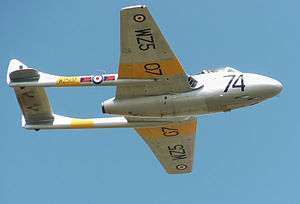 | |
| Vampire T.11 of the UK Vampire Preservation Group displays at the Cotswold Air Show | |
| Role | Fighter aircraft |
| National origin | United Kingdom |
| Manufacturer | de Havilland English Electric |
| First flight | 20 September 1943 |
| Introduction | 1946 |
| Retired | 1979 Rhodesian Air Force |
| Primary users | Royal Air Force Royal Navy |
| Number built | 3,268[1] |
| Developed into | de Havilland Venom |
The de Havilland Vampire is a British jet fighter developed and manufactured by the de Havilland Aircraft Company. Development of the aircraft began during the Second World War as an aircraft suitable for combat that harnessed the new innovation of jet propulsion; it was quickly decided to opt for a single-engine, twin-boom aircraft equipped with the Halford H.1 turbojet engine, which was later known as the de Havilland Goblin. Originally ordered as an experimental aircraft only, the decision to mass-produce the aircraft as an interceptor for the Royal Air Force (RAF) was finalised in May 1944.
In 1946, the first production aircraft entered service with the RAF, months after the conflict had come to a close. The Vampire was the second jet fighter, after the Gloster Meteor, operated by the RAF, and it was the service's first to be powered by a single jet engine. Aside from its propulsion system and twin-boom configuration, it was a relatively conventional and unsophisticated aircraft. The Vampire was quickly used to replace many wartime piston-engine fighter aircraft. The RAF operated it as a front-line fighter until 1953, after which the Vampire was primarily assigned to secondary roles such as pilot training as well as ground attack operations, for which dedicated variants of the type were produced.
In 1966, the type was retired entirely by the RAF, having been replaced by more capable jet-powered fighters such as the Hawker Hunter and Gloster Javelin. During its service, the Vampire had achieved several aviation firsts and records, including becoming the first jet aircraft to traverse the Atlantic Ocean. It had been largely successfully upon the export market, having been sold to many other nations and operated by a wide range of diverse air forces around the world. It participated in conflicts including the 1948 Arab–Israeli War, the Malayan emergency and the Rhodesian Bush War.
Almost 3,300 Vampires were manufactured, a quarter of them built under licence in other countries. The Royal Navy's first jet fighter was the Sea Vampire, a navalised variant which was operated from its aircraft carriers. The Vampire was developed into the DH.115 dual-seat trainer and the more advanced DH.112 Venom ground-attack and night fighter.
Development
Origins
In January 1941, Sir Henry Tizard made an informal approach to the de Havilland Aircraft Company, suggesting that the company proceed to design a fighter aircraft that would harness the revolutionary in-development jet propulsion technology, along with an appropriate engine to go with it. While no official specification had then been issued, de Havilland decided to proceed with an exploration of the concept; the company quickly conceived of a single-engined aircraft that had air-intakes set into the wing roots to feed a centrally-mounted engine, which made use of centrifugal design. The aero-engine designer Major Frank Halford had been given access to Frank Whittle's pioneering work on gas turbines; for the projected jet-powered fighter, Halford decided to proceed with the design of a "straight through" centrifugal engine capable of generating 3,000 lb of thrust, which was considered to be high at the time. Halford's engine was developed, and emerged as the Halford H.1. By April 1941, design work on the engine had been completed; a prototype H.1 engine performed its first test run one year later.[2]
The low power output of the early jet engines had meant that only twin-engined aircraft designs were considered to be practical during the early stages of development; however, as more powerful jet engines were quickly developed, particularly Halford's H.1 (later known as the de Havilland Goblin), the practicalities of single-engined jet fighter were soon realized.[3] de Havilland were approached to produce an airframe for the H.1 as insurance against Germany using jet bombers against Britain; this was considered more important that de Havilland's own suggestion of a high-speed jet bomber.[4] Their first design, designated as the DH.99, was an all-metal, twin-boom, tricycle undercarriage aircraft armed with four cannon. The use of a twin boom enabled the jet pipe to be kept relatively short, which avoided the power loss that would have occurred if a long pipe was used, as would have been necessary by a conventional fuselage. It also put the rudder empennage clear of interference from the exhaust. Performance was estimated at 455 miles per hour (732 km/h) at sea level and initial climb of 4,590 ft/min (1,400 m/min) on 2,700 lb thrust. The Ministry of Aircraft Production (MAP) expressed doubts regarding the estimations for the aircraft's performance and weight; however, the project received permission to proceed in July 1941.[4]
The DH.99 design was soon modified to incorporate a combined wood-and-metal construction in light of recommendations from the MAP; the design was thus renumbered to DH.100 by November 1941. The aircraft was considered to be a largely experimental design due to its use of a single engine and some unorthodox features, unlike the Gloster Meteor which had been specified for production early on.[3] In February 1942, the MAP suggested dropping the project for a bomber but de Havilland stated that the twin-boom was, despite Ministry doubts, only an engineering problem to be overcome. On 22 April 1942, the construction of two prototypes (serials LZ548 and LZ551) was authorized by the Ministry while Specification E.6/41 was produced and issued to cover the work.[5] Accordingly, the company proceeded with the detailed design work phase of the DH.100 in early 1942.
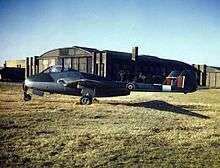
Internally designated as the DH.100 and originally named the "Spider Crab", the aircraft was entirely a de Havilland project, being principally worked upon at the company's facility at Hatfield, Hertfordshire.[6] The construction of the aircraft exploited de Havilland's extensive experience in the use of moulded plywood for aircraft construction; many design features that were used upon the DH.100, such as the fuselage nacelle and tall triangular vertical surfaces, had been present on the company's preceding Mosquito, a widely produced fast bomber of the war.[7]
The layout of the DH.100 adopted a single jet engine which was placed within an egg-shaped fuselage, the latter being primarily composed of plywood for the forward section and aluminium throughout the aft section, completed with conventional straight mid-mounted wings. Air brakes were present upon the wings to slow the aircraft to better enable it to manoeuvre into a firing position behind slower aircraft - a feature that had also been incorporated in the Meteor. Armament comprised four 20mm Hispano Mk V cannon located underneath the nose; from the onset of the design phase of development, even when the aircraft was officially intended to serve only as an experimental aircraft, the provision for the cannon armament had been included.[7]
On 20 September 1943, the first DH.100 prototype, serial number LZ548/G, conducted its maiden flight from Hatfield Aerodrome; it was piloted by Geoffrey de Havilland Jr, the company's chief test pilot and son of the company's founder.[8] This flight took place only six months after the Meteor had performed its own maiden flight; the first flight had been delayed due to the need to dispatch the only available engine suitable for flight to America to replace one destroyed in ground engine runs in Lockheed's prototype XP-80 jet fighter. A total of three prototypes, LZ548/G, LZ551/G, and MP838/G were produced in order to support the type's development.[7]
Production and further development
On 13 May 1944, an initial production order for 120 Vampire Mk I aircraft was received; it was quickly increased to 300 aircraft soon thereafter.[7] The production Vampire Mk I did not fly until April 1945. Due to the extensive wartime pressures upon de Havilland's production facilities for existing aircraft type, English Electric Aircraft undertook production of the Vampire at their Preston, Lancashire factories instead; the company would go onto produce the majority of the aircraft. Only about half a dozen production aircraft had been built by the end of the Second World War, although it did not result in the type becoming a victim of the extensive post-war cutbacks that were soon implemented, terminating the production of many existing types along with the development of several more.[7]

De Havilland initiated a private venture night fighter, the DH.113 intended for export, fitting a two-seat cockpit closely based on that of the Mosquito night fighter, and a lengthened nose accommodating AI Mk X radar. An order to supply the Egyptian Air Force was received, but this was blocked by the British government as part of a general ban on supplying arms to Egypt. Instead the RAF took over the order and put them into service as an interim measure between the retirement of the de Havilland Mosquito night fighter and the full introduction of the Meteor night fighter.[9] Removal of the radar from the night fighter and fitting of dual controls gave a jet trainer, the DH.115 Vampire which entered British service as the Vampire T.11. This was built in large numbers, both for the RAF and for export.[10]
A total of 3,268 Vampires were built in 15 versions, including a twin-seat night fighter, a trainer and a carrier-based aircraft designated Sea Vampire. The Vampire was used by some 31 air forces. Germany, the Netherlands, Spain and the U.S. were the only major Western powers not to use the aircraft type.
Records and achievements

On 8 June 1946, the Vampire was introduced to the British public when Fighter Command's 247 Squadron was given the honour of leading the flypast over London at the Victory Day Celebrations.[11] The Vampire was a versatile aircraft, setting many aviation firsts and records, being the first RAF fighter with a top speed in excess of 500 mph (800 km/h). On 3 December 1945, a Sea Vampire piloted by Captain Eric "Winkle" Brown became the first pure-jet aircraft to land on and take off from an aircraft carrier.[12][N 1]
Vampires were used in trials from 1947 to 1955 to develop undercarriage-less fighters that could operate from flexible rubber decks on aircraft carriers, which would allow the weight and complication of an undercarriage to be eliminated.[14] Despite demonstrating that the technique was practicable, with many landings being made with undercarriage retracted on flexible decks both at RAE Farnborough and on board the carrier HMS Warrior, the proposal was not taken further.[15] On 23 March 1948, John Cunningham, flying a modified Mk I with extended wing tips and powered by a de Havilland Ghost engine, set a new world altitude record of 59,446 ft (18,119 m).[16]
On 14 July 1948, six Vampire F.3s of No. 54 Squadron RAF became the first jet aircraft to fly across the Atlantic Ocean when they arrived in Goose Bay, Labrador. They went via Stornoway in the Outer Hebrides of Scotland, Keflavik in Iceland and Bluie West 1, Greenland. From Goose Bay airfield they went on to Montreal (c. 3,000 mi/4,830 km) to start the RAF's annual goodwill tour of Canada and the US, where they gave formation aerobatic displays.[17] At the same time USAF Colonel David C. Schilling led a group of F-80 Shooting Stars flying to Fürstenfeldbruck Air Base in Germany to relieve a unit based there. There were conflicting reports later regarding competition between the RAF and USAF to be the first to fly the Atlantic. One report said the USAF squadron delayed completion of its movement to allow the Vampires to be "the first jets across the Atlantic".[18] Another said that the Vampire pilots celebrated “winning the race against the rival F-80s.”[19]
Design
The de Havilland Vampire was a jet-powered twin-boom aircraft, typically employed in the fighter and fighter bomber roles.[7] Aviation author Francis K Mason referred to it as being "the last unsophisticated single-engine front line aircraft to serve with Britain's Fighter Command"; the Vampire was a relatively straightforward aircraft, employing only manually-operated flight controls, no radar, a simple airframe, and, aside from the propulsion system, was otherwise relatively conventional.[7] The use of a twin-boom tail configuration was one of the only non-traditional elements of the airframe in comparison to its contemporaries.[7]
The Vampire was first powered by a single Halford H1 (later and more widely known as the de Havilland Goblin) turbojet engine, initially capable of producing 2,100 lbf (9.3 kN) of thrust, designed by Frank B Halford and manufactured by de Havilland. This engine was a centrifugal-flow type, a design later superseded after 1949 by the slimmer axial-flow units. In 1947, Wing Commander Maurice Smith, assistant editor of Flight magazine, stated upon piloting his first jet-powered aircraft, a Vampire Mk III: "Piloting a jet aircraft has confirmed one opinion I had formed after flying as a passenger in the Lancastrian jet test beds, that few, if any, having flown in a jet-propelled transport, will wish to revert to the noise, vibration and attendant fatigue of an airscrew-propelled piston-engined aircraft".[20]
Initially, the relatively high fuel consumption of the Goblin engine had provided early service models of the Vampire with a disappointingly limited range, a common problem to all of the early jet aircraft; later marks of the type featured greatly increased internal fuel capacities as a result. As improvements to the aircraft were implemented, the engine was subject to considerable alterations and upgrades, often to incorporate the rapid advances made in jet propulsion early on. Later-built Vampire Mk Is were powered by the Goblin II; the F.3 onwards used the improved Goblin III instead. Certain marks were also operated as aerial test-beds for the Rolls-Royce Nene engine, leading to the FB30 and 31 variants built in Australia. Due to the low positioning of the engine, a Vampire could not remain on idle for long as the heat from the jet exhaust would melt the tarmac behind the aircraft.
Operational history
United Kingdom
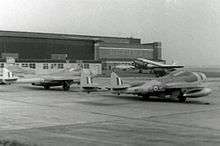
- Royal Air Force
In 1946, the first Vampire Mk I fighters entered RAF service in the interceptor role.[7][N 2] Soon thereafter, considerable numbers of Mk I aircraft began equipping RAF squadrons of the Second Tactical Air Force stationed in Germany, often to replace wartime fighters such as the Hawker Typhoon, Hawker Tempest, and North American Mustang. On 3 July 1948, the Vampire became the first jet aircraft to equip peacetime units of the Royal Auxiliary Air Force, gradually replacing the de Havilland Mosquito in this capacity.[7]
The first prototype of the "Vampire Fighter-Bomber Mk 5" (FB.5), modified from a Vampire F.3, carried out its initial flight on 23 June 1948. The FB.5 retained the Goblin III engine of the F.3, but featured armour protection around engine systems, wings clipped back by 1 ft (30 cm), and longer-stroke main landing gear to handle greater takeoff weights and provide clearance for stores/weapons load. An external tank or 500 lb (227 kg) bomb could be carried under each wing, and eight "3-inch" rocket projectiles ("RPs") could be stacked in pairs on four attachments inboard of the booms. Although an ejection seat was considered, it was not fitted.
At its peak, 19 RAF squadrons flew the FB.5 in Europe, the Middle East and the Far East. The FB.5 undertook attack missions during the British Commonwealth's campaign to suppress the insurgency in Malaya in the late 1940s and early 1950s. The FB.5 fighter-bomber became the most numerous single-seat variant with 473 aircraft produced.
The NF.10 served from 1951 to 1954 with three squadrons (23, 25 and 151) but was often flown in daytime as well as night time. After replacement by the Venom conversions were made to NF(T).10 standard for operation by the Central Navigation and Control School at RAF Shawbury. Others were sold to the Indian Air Force.
The RAF eventually relegated the single-seat Vampire to advanced training roles in the mid-1950s, and the type was generally out of RAF service by the end of the decade.
The final Vampire was the T (trainer) model. First flown from the old Airspeed Ltd factory at Christchurch, Hampshire on 15 November 1950, production deliveries of the trainer began in January 1952. Over 600 examples of the T.11 were produced at Hatfield and Chester and by Fairey Aviation at Manchester Airport.
With the replacement in the training role by the BAC Jet Provost by 1965 only a small number of Vampire T.11s were in service for training foreign students until they were retired in 1967.[22] A small number of aircraft in secondary roles carried on until the last operational aircraft were withdrawn from service with No. 3 Civilian Anti-Aircraft Co-operation Unit at Exeter at the end of 1971.[22]
One aircraft continued in service with the Royal Air Force as part of the "Vintage Pair" display team (along with a Gloster Meteor) until it crashed in 1986.[22]
- Royal Navy
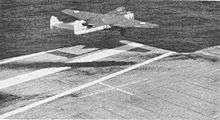
Following carrier-landing trials on the carrier HMS Ocean with a modified prototype Vampire, the Royal Navy ordered a navalised variant of the Vampire FB.5 as the Sea Vampire, the first Royal Navy jet aircraft. Two prototypes were followed by 18 production aircraft which were used to gain experience in carrier jet operations before the arrival of the two-seat Sea Vampire T.22 trainers.[23]
Australia
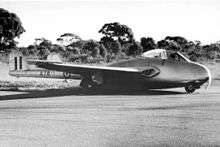
In 1946 approval was given for the purchase of an initial 50 Vampire aircraft for the RAAF. The first three machines were British-built aircraft, an F1, F2 and FB.5, and were given serial numbers A78-1 to A78-3.
The second aircraft, the F2 (A78-2), was significant in that it was powered by the more powerful Rolls-Royce Nene jet engine, rather than the usual Goblin. All 80 F.30 fighters and FB.31 fighter-bomber aircraft built by de Havilland Australia were to be powered by Commonwealth Aircraft Corporation versions of the Nene engine manufactured under licence in Melbourne. The Nene required a greater intake cross-section than the Goblin, and the initial solution was to mount auxiliary intakes on top of the fuselage behind the canopy. Unfortunately these intakes led to elevator blanking on formation of shock waves, and three aircraft and pilots were lost in unrecoverable dives. All Nene-engined aircraft were later modified to have the auxiliary intakes beneath the fuselage, thus avoiding the problem.
The first Vampire F.30 fighter (A79-1) flew in June 1949, and it was followed by 56 more F.30 variants before the final 23 aircraft were completed as FB.31s with strengthened and clipped wings with underwing hardpoints. The last FB.31 was delivered in August 1953, and 24 late-production F.30s were subsequently upgraded to FB.31 standard. Single seat Vampires were retired in the RAAF in 1954.
The T.33, T.34 and T.35 were used by the RAAF and the Royal Australian Navy (RAN) (known as Mk33 through to Mk35W in RAAF service) and many were manufactured or assembled at de Havilland Australia's facilities in Sydney. The Mk35W was a Mk35 fitted with spare Mk33 wings following overstress or achievement of fatigue life. Vampire trainer production in Australia amounted to 110 aircraft, and the initial order was filled by 35 T.33s for the RAAF, deliveries being made in 1952 with five T.34s for the RAN delivered in 1954. The trainers remained in service in the RAAF until 1970 while RAN Vampires were retired in 1971.[24]
Canada
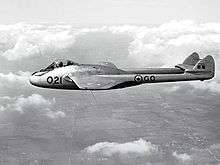
An F.1 version began operating on an evaluation basis in Canada at the Winter Experimental Establishment in Edmonton in 1946. The F.3 was chosen as one of two types of operational fighters for the Royal Canadian Air Force and was first flown in Canada on 17 January 1948 where it went into service as a Central Flying School training aircraft at RCAF Station Trenton. With 86 in total, the F.3 was the first jet fighter to enter RCAF service in any significant numbers. It served to introduce fighter pilots not only to jet flying, but also to cockpit pressurization and the tricycle landing gear. The "Vamp" was a popular aircraft, easy to fly and considered a "hot rod."[25] It served in both operational and air reserve units (400, 401, 402, 411, 438 and 442 squadrons) until retirement in the late 1950s when it was replaced by the Canadair Sabre.[26]
Egypt
In 1954, Egypt was operating 49 Vampires, which had been acquired from both Italy and Britain, as fighter-bombers.[27] In 1955, twelve Vampire trainers were ordered, deliveries of which started in July that year.[28] During the Suez Crisis, the Egyptian Air Force is recorded as having lost a total of four Vampires in combat with Israeli jet aircraft.[29]
Finland
The Finnish Air Force received six FB.52 Vampires in 1953. The model was nicknamed "Vamppi" in Finnish service. An additional nine twin-seat T.55s were purchased in 1955. The aircraft were assigned to 2nd Wing at Pori, but were transferred to 1st Wing at Tikkakoski at the end of the 1950s. The last Finnish Vampire was decommissioned in 1965.
France
As part of a larger effort to build up the post-war French Air Force, a number of Goblin-powered Vampire FB.5s were delivered to France from 1949 onwards; the Vampire was subsequently manufactured under licence by Sud-Est at Marignane, the first 67 aircraft were assembled from British-produced components followed by another 183 aircraft incorporating a greater proportion of French-produced elements.[30][31] The French developed the FB.53, a Nene-powered variant which was named in French service as the Mistral. 250 were built with Hispano-Suiza built engines, French ejector seats and an enlarged wing root ducts. The first Mistral flew on 2 April 1951.[31]
India
No. 7 Squadron, Indian Air Force (IAF) received Vampires in January 1949. No. 17 Squadron IAF also operated the type. No. 37 Squadron IAF flew a number of Vampire NF54 night reconnaissance missions over Goa during the 1961 Indian annexation of Portuguese India, sometimes coming under anti-aircraft fire.[32]
On 1 September 1965, during the Indo-Pakistani War, No. 45 Squadron IAF responded to a request for strikes against a counter-attack by the Pakistani Army (Operation Grand Slam), and twelve Vampire Mk 52 fighter-bombers were successful in slowing the Pakistani advance. However, the Vampires encountered two Pakistan Air Force (PAF) F-86 Sabres, armed with air-to-air missiles; in the ensuing dogfight, the outdated Vampires were outclassed. One was shot down by ground fire and another three were shot down by Sabres.[33][34] The Vampires were withdrawn from front line service after these losses.
Italy
The Vampire was licensed-built in Italy for the Italian Air Force, Macchi at Varese and Fiat at Turin built 80 Vampire FB.52s. Italy later ordered 14 Vampire NF.10s designated the NF.52.
Norway
The Royal Norwegian Air Force purchased 20 Vampires F.3s, 36 FB.52s and six T.55 trainers. The Vampire was in use in Norway from 1948 to 1957 equipping a three-squadron Vampire wing at Gardermoen. The Vampires were withdrawn in 1957 when the air force re-equipped with the Republic F-84G Thunderjet. The Vampire trainers were replaced by the Lockheed T-33 in 1955 and returned to the United Kingdom and used by the Royal Air Force.
Sweden
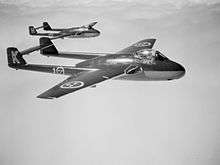
The Swedish Air Force purchased its first batch of 70 FB 1 Vampires in 1946, looking for a jet to replace the already outdated SAAB 21 and J 22s of its fighter force. The aircraft was designated J 28A and was assigned to the F 13 Norrköping Wing. It provided such good service that it was selected to be the backbone of the fighter force. A total of 310 of the more modern FB.50s, designated J 28B, were purchased in 1949. The last one was delivered in 1952, after which all piston-engined fighters were decommissioned. In addition, a total of 57 two-seater DH 115 Vampires named J 28C were used for training.
The Swedish Vampires were retired as fighters in 1956 and replaced with the J 29 (SAAB Tunnan) and J 34 (Hawker Hunter). The last Vampire trainer was retired in 1968.
Switzerland
_Vampire_T55_(DH-115)_AN2244396.jpg)
In 1946 the Swiss Air Force purchased four Vampire F.1s, one aircraft crashed on 2 August 1946, the other three remained in service until 1961. In 1949 the Swiss government signed a contract to build the Vampire in Switzerland using British-built Goblin engines, and a batch of 85 Vampire FB.6s were built.[35][31] In 1952 the first production Vampire NF.10 was delivered to Switzerland for evaluation.[36]
The first batch of 75 DH-100 Mk.6 (J-1005 to J-1079) was purchased in 1949. Most of them passed out of service in 1968/1969, the last ones in 1973. The second batch was 100 DH-100 Mk.6 (J-1101 to J-1200) built under licence by the Swiss aviation industry. In use from 1951 to 1974 and in storage until 1988. Three DH-100 Mk.6 (J-1080 to J-1082) were built from spare parts. 39 DH-115 Mk 55 Vampire two-seat trainers (U-1201 to U-1239) from 1953 to 1990.[37][38]
Rhodesia
_(8643525896).jpg)
The Rhodesian Air Force acquired 16 Vampire FB.9 fighters and a further 16 Vampire T.11 trainers in the early 1950s, its first jet aircraft, equipping two squadrons.[39] These were regularly deployed to Aden between 1957 and 1961, supporting British counter-insurgency operations.[40] 21 more two-seaters and 13 single-seaters were supplied by South Africa in the late 1960s and early 1970s.[41] Rhodesia operated Vampires until the end of the bush war in 1979. In 1977, six were pressed into service for Operation Dingo. They were eventually replaced by the BAe Hawk 60 in the early 1980s. After 30 years service, they were the last Vampires used on operations anywhere.[42]
Variants
- DH.100: three prototypes to specification E.6/41.
- LZ548 first flown 20 September 1943
- LZ551 first flown 17 March 1944 and modified for deck landing trials, the first jet aircraft to land on an aircraft carrier, on display in 2013 at the Fleet Air Arm Museum.
- MP838 first flown on 21 January 1944, the first armed aircraft.
- Vampire Mk I: single-seat fighter version for the RAF; 244 production aircraft being built.
- Mk II: three prototypes, with Rolls-Royce Nene turbojet engine. One built and two conversions.
- F.3: single-seat fighter for the RAF. Two prototypes were converted from the Mk 1; 202 production aircraft were built, 20 were exported to Norway
- Mk IV: Nene-engined project, not built.
- FB.5: single-seat fighter-bomber version. Powered by the Goblin 2 turbojet; 930 built for the RAF and 88 for export.
- FB.6: single-seat fighter-bomber. Powered by a Goblin 3 turbojet; 178 built, 100 built in Switzerland for the Swiss Air Force.
- Mk 8: Ghost-engined, one conversion from Mk 1.
- FB.9: tropicalised fighter-bomber through addition of air conditioning to Mark 5. Powered by Goblin 3 turbojet; 326 built, mostly by de Havilland, but also by Fairey Aviation.
- Mk 10 or DH.113 Vampire: Goblin-powered two-seater prototype; two built.
- NF.10: two-seat night fighter version for the RAF; 95 built including 29 as the NF.54.
- Sea Vampire Mk 10: prototype for deck trials. One conversion.
- Mk 11 or DH.115 Vampire Trainer: private venture, two-seat jet trainer prototype.
- T.11: two-seat training version. Powered by a Goblin 35 turbojet; 731 were built by DH and Fairey Aviation. Some fitted with ejection seats.
- Sea Vampire F.20: naval version of the FB.5; 18 built by English Electric.
- Sea Vampire F.21: six aircraft converted from F.3s with strengthened belly and arrester hook for trials of undercarriage-less landings on flexible decks.[43]
- Sea Vampire T.22: two-seat training version for the Royal Navy; 73 built by De Havilland.
- FB.25: FB.5 variants; 25 exported to New Zealand
- F.30: single-seat fighter-bomber version for the RAAF. Powered by Rolls-Royce Nene turbojet; 80 built in Australia.
- FB.31: Nene-engined, 29 built in Australia.
- F.32: one Australian conversion with air conditioning.
- T.33: two-seat training version. Powered by the Goblin turbojet; 36 were built in Australia.
- T.34: two-seat training version for the Royal Australian Navy; five were built in Australia.
- T.34A: Vampire T.34s fitted with ejection seats.
- T.35: modified two-seat training version; 68 built in Australia.
- T.35A: T.33 conversions to T.35 configuration.
- FB.50: exported to Sweden as the J 28B; 310 built, 12 of which were eventually rebuilt to T.55 standard.
- FB.51: export prototype (one conversion) to France.
- FB.52: export version of Mk 6, 101 built; 36 exported to Norway and in use from 1949 to 1957
- FB.52A: single-seat fighter-bomber for the Italian Air Force; 80 built in Italy.
- NF.54: export version of Vampire NF.10 for the Italian Air Force; 29 being built.
- T.55: export version of the DH.115 trainer; 216 built and six converted from the T.11.
- S.N.C.A.S.E. 'Vampire' FB.53: Four pre-series single-seat fighter-bombers for the Armee de l'Air; 250 built in France, as the Sud-Est SE 535 Mistral.
- S.N.C.A.S.E. SE-532 Mistral: Initial production version of the Mk.53 for the Armée de l'Air; 97 built.
- S.N.C.A.S.E. SE-535 Mistral: Development of the SE-532, 150 built for the Armée de l'Air.
Operators
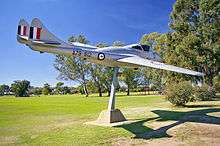
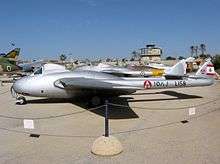
.jpg)
 Austria
Austria Australia
Australia.svg.png) Burma
Burma Canada
Canada.svg.png) Ceylon
Ceylon Chile
Chile Dominican Republic
Dominican Republic Egypt
Egypt Finland
Finland France
France India
India Indonesia
Indonesia.svg.png) Iraq
Iraq Ireland
Ireland Italy
Italy Japan
Japan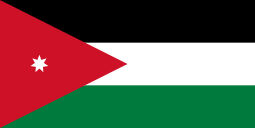 Jordan
Jordan Katanga
Katanga Lebanon
Lebanon Mexico
Mexico New Zealand
New Zealand Norway
Norway Portugal
Portugal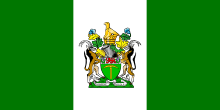 Rhodesia
Rhodesia Saudi Arabia
Saudi Arabia.svg.png) South Africa
South Africa Sweden
Sweden Switzerland
Switzerland Syria
Syria United Kingdom
United Kingdom.svg.png) Venezuela
Venezuela Zimbabwe
Zimbabwe
Surviving aircraft
Although today over eighty Vampires are still airworthy, only a small number are flying.
Australia
- One ex-Australian two-seat Mk 35W Vampire, S/N A79-617 was restored by Red Star Aviation of Hackettstown, New Jersey and then repatriated to Australia, where it is displayed in air shows. Two ex-RAAF Mk 35s (A79-637 and A79-665) are owned by the Historical Aircraft Restoration Society (HARS) at Illawarra Regional Airport, NSW, one of which is being restored to flying condition.
Canada
- One ex-Swiss DH-115 Mk 55 two-seat Vampire (U-1213) is airworthy and flying with Waterloo Warbirds.
New Zealand
- An ex-RNZAF T.11, on loan from RNZAF Museum, Christchurch was being restored at the New Zealand Fighter Pilots Museum.[44]
Norway
- Two other ex-Swiss vampires, a T.55 and an FB.52 are operated by the Norweigian Airforce Historical Squadron, and fly at many displays in Europe[45]
South Africa
- As of November 2015, serial numbers 276 and 277 are flown by the SA Air Force Museum and a third flyable Vampire is at Wonderboom Airport.
Sweden
Switzerland
- Two DH-100 Mk.6(HB-RVH & HB-RVN) and two DH-115 Trainer (HB-RVF & HB-RVJ)
United Kingdom
- An ex-Swiss Vampire T.55 was brought to the UK and repainted in RAF camouflage, and is now operated by the Classic Air Force out of Coventry airport registered as G-HELV.[48] An airworthy Vampire T.11 is operated by the Vampire Preservation Group from North Weald in Essex, UK.[49]
United States
- Several ex-Swiss and ex-Australian Vampires operate as collectors' aircraft in the United States. Several other US-based Vampires are abandoned and in disrepair.
Aircraft on display
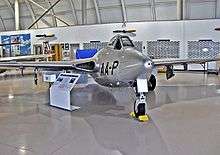
Examples of the de Havilland Vampire on display include:
- Australia
RAAF Museum Point Cook Victoria. F.30. Fighter World, Williamtown, NSW. A79-1 the first jet aircraft to be built in Australia.
- Forbes, New South Wales. Monument next to Lake Forbes, ex-RAAF A79-109.
- Tamworth, Australia, Hands of Fame Park.
- Temora Aviation Museum, New South Wales, ex-RAAF A79-617 (Flying condition)
- Wagga Wagga, New South Wales, ex-RAAF A79-612 on pylon in Bolton Park next to the Sturt Highway
- Wingham, New South Wales ex-RAAF A79-593 on pylon in Central Park.
- Braybrook, Victoria, Central West Plaza shopping centre.
- Gnangara Road, Landsdale, Perth, Western Australia - "Snoopy" on a pylon next to a machinery yard.
- RAAF Townsville Aviation Heritage Centre (A79-656 and A79-804) DH.115 Vampire T.35[50]
- Austria
- Austrian Airforce Museum Zeltweg/Styria (Zeltweg Air Base) (Vampire Two Seat Trainer).
- Belgium
- Royal Museum of the Armed Forces and Military History (Vampire T.11)
- Canada
- Aero Space Museum, Calgary, Alberta (Vampire F.3)[51]
- Alberta Aviation Museum (Vampire T.35 (1964))[52]
- Canada Aviation and Space Museum (Vampire Mk 3).[53]
- Canadian Warplane Heritage Museum.[54]
- Canadian Museum of Flight.[55]
- Comox Air Force Museum (Vampire Mk 3).[56]
- Reynolds-Alberta Museum.
- Chile
- Museo Nacional Aeronáutico y del Espacio, two examples, one is being refurbished for display during 2014.
- One example exhibited inside Cerro Moreno, Antofagasta AFB.
- One example as gate guardian of Diego Aracena AFB of Iquique.
- An example placed in a restaurant of Antofagasta city in northern Chile.
- A Vampire was previously placed on a pole in the intersection of Gran Avenida and Américo Vespucio in Santiago, Chile but was destroyed due to a bombing attack in the 1980s, remains are in the open at Los Cerrillos Museo Aeronáutico.
- Czech Republic
- Letecke Muzeum Kbely.
- Finland
- Aviation Museum of Central Finland (three examples of Vampire Mk 52 and two examples of Mk 55 in storage).
- Finnish Aviation Museum (one Vampire Mk.52 and one Vampire T.55 trainer)[57]
- Germany
- India
- Indian Air Force Museum, Palam, New Delhi.
- Naval Aviation Museum Goa.
- Air Force Technical College, Bangalore.
- Indonesia
- Indonesian Air Force Dirgantara Mandala Museum, Adisutjipto Air Force Base, Yogyakarta.
- Ireland
- Collins Barracks (Dublin) as part of the National Museum of Ireland.
- Israel
- Italy
- Volandia (DH-100 FB.6).[59]
- Italian Air Force Museum (DH-113 NF Mk.54).[60]
- Japan
- Japan Air Self-Defense Force Hamamatsu Air Base Publication Center in Hamamatsu, Japan (Vampire T.55) 63-5571 (Formerly G-5-14).[61]
- Lebanon
- Lebanese Air Force Museum at Rayak Air Base in Rayak. A de Havilland Vampire T.55 is on display.[62]
- Malta
- Malta Aviation Museum, Ta' Qali in Malta. (Vampire T.11).
- México
- Mexican Military Aviation Museum in Mexico. (Vampire Mk.I).
- Mexican Army and Air Force Museum in Jalisco. (Vampire Mk.I).
- New Zealand
- Museum of Transport and Technology in Auckland, New Zealand (Vampire FB.9).[63]
- RNZAF Ohakea (Vampire FB.9) gate guard.[64]
- Royal New Zealand Air Force Museum.[65]
- Southward Car Museum.
- Ashburton Aviation Museum (Vampire T.11).
- Poland
- Polish Aviation Museum, Kraków, Swiss-built Mk.6.
- Saudi Arabia
- South Africa
- SAAF 205 FB.52 South African Air Force Museum, AFB Port Elizabeth, Static display.
- SAAF 208 FB.52 South African Air Force Museum, AFB Ysterplaat, Cape Town, Static display.[66]
- SAAF 229 FB.52 South African Air Force Museum, AFB Swartkop, Pretoria, Static Display.[67]
- SAAF 277 TMk55 South African Air Force Museum, AFB Swartkop, Pretoria, Airworthy.[68]
.jpg)
- United Kingdom
- F.1 VF301 on display at the Midland Air Museum, Coventry, England.[69]
- FB.5 WA346 under restoration at the Royal Air Force Museum Cosford, England.
- T.11 XD382 on static display at East Midlands Aeropark.
- T.11 XD447 on static display at East Midlands Aeropark.
- T.11 XD593 on display at the Newark Air Museum, England.[70]
- T.11 XD626 on display at the Midland Air Museum, Coventry, England.[69]
- T.11 XE855 on display at the Midland Air Museum, Coventry, England.[69]
- T.11 XE935 on display at the South Yorkshire Aircraft Museum, Doncaster, England
- T.11 XH278 On display at Yorkshire Air Museum, Elvington, Yorkshire.[71]
- T.11 XH313 on display at the Tangmere Military Aviation Museum, England[72]
- T.11 XJ772 on display at the de Havilland Aircraft Heritage Centre, Hertfordshire, England[73]
- T.11 XK590 on display at the Wellesbourne Wartime Museum, Warwickshire, England.[74]
- T.11 XK624 on display at the Norfolk and Suffolk Aviation Museum, Flixton, England.[75]
- T.11 WZ515 on display at the Solway Aviation Museum, Carlisle, England.[76]
- T.11 WZ518 on display at the North East Aircraft Museum, Sunderland, England.[77]
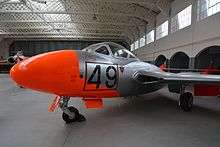
- T.11 WZ590 on display at the Imperial War Museum Duxford, England.[78]
- T.11 on display at Headquarters No. 2247 (Hawarden) Squadron Air Training Corps, Hawarden, Flintshire, Wales.
- T.11 XK623 on display at Caernarfon Airworld Museum.[79]
- T.22 XA109 on display at Montrose Air Station Heritage Centre, Angus, Scotland.[80]
- United States
- Pima Air & Space Museum, adjacent to Davis-Monthan AFB in Tucson, Arizona.[81]
- Evergreen Aviation Museum in McMinnville, Oregon.
- Planes of Fame Air Museum in Valle-Williams Arizona.
- An ex-Swiss example is displayed at the Quonset Air Museum, North Kingstown, RI, USA, and is owned and flown by the Red Star Aviation Museum.
- Venezuela
- FB.52 (3C35) and T.11 (IE35) at the Aeronautics Museum of Maracay, Venezuela.[82]
Specifications (Vampire FB.6)
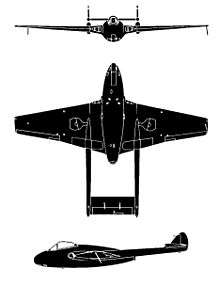
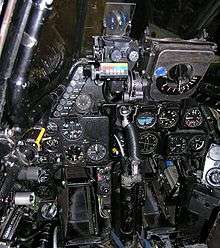
Data from The Illustrated Encyclopedia of Aircraft[83]
General characteristics
- Crew: 1
- Length: 30 ft 9 in (9.37 m)
- Wingspan: 38 ft (11.58 m)
- Height: 8 ft 10 in (2.69 m)
- Wing area: 262 ft² (24.34 m²)
- Empty weight: 7,283 lb (3,304 kg)
- Max. takeoff weight: 12,390 lb [84] (5,620 kg)
- Powerplant: 1 × de Havilland Goblin 3 centrifugal turbojet, 3,350 lbf (14.90 kN)
Performance
- Maximum speed: 548 mph (882 km/h)
- Range: 1,220 mi (1,960 km)
- Service ceiling: 42,800 ft (13,045 m)
- Rate of climb: 4,800 ft/min[84] (24.4 m/s)
Armament
- Guns: 4 × 20 mm (0.79 in) Hispano Mk.V cannon with 600 Rounds total (150 RPG).
- Rockets: 8 × 3-inch "60 lb" rockets
- Bombs: or 2 × 500 lb (225 kg) bombs or two drop-tanks
Notable appearances in media
See also
- Portal:British aircraft since World War II
- Related development
- Aircraft of comparable role, configuration and era
- Related lists
References
Notes
- ↑ On 6 November 1945, a Ryan FR Fireball, designed to utilize its piston engine during takeoff and landing, had a piston engine failure on final approach. The pilot started the jet engine, performing the first jet-powered carrier landing, albeit unintentionally, although the Fireball was not a high performance jet fighter like the Vampire.[13]
- ↑ Quote: "The Vampire had been conceived during the war as a high-altitude fighter..."[21]
Citations
- ↑ Gunston 1981, p. 52.
- ↑ Gunston, Bill. "World Encyclopedia of Aero Engines - 5th edition." Sutton Publishing, 2006. p. 62.
- 1 2 Buttler 2000, p. 201.
- 1 2 Buttler 2004, p. 201.
- ↑ Buttler 2004 p. 203.
- ↑ Gunston 1981, p. 49.
- 1 2 3 4 5 6 7 8 9 10 Mason 1965, p. 3.
- ↑ Gunston 1981, p. 50.
- ↑ Jackson 1987, p. 484.
- ↑ Jackson 1987, pp. 496—501.
- ↑ Gunston 1992, p. 454.
- ↑ Brown 1985, pp. 32–34.
- ↑ "First Jet Landing", Naval Aviation News, United States Navy: 6, March 1946
- ↑ Brown 1976, pp. 126–7.
- ↑ Brown 1976, pp. 132–6.
- ↑ Jackson 1987, p. 424.
- ↑ "How The Vampires Crossed", Flight, LIV (2065): 105, 22 July 1948
- ↑ Dorr 1998, p. 119.
- ↑ Wood, William ‘Bill’ (1997), Only Birds and Fools Fly, UK, retrieved 6 October 2009
- ↑ Smith, Maurice (27 November 1947), "'Flight' Pilots a Jet", Flight, LII (2031): 610
- ↑ Watkins 1996, p. 58.
- 1 2 3 Jackson 1987, p. 499.
- ↑ Jackson 1987, pp. 429-430.
- ↑ "RAAF Museum: RAAF Aircraft Series 2 A79 DHA Vampire". airforce.gov.au.
- ↑ Milberry 1984, p. 212.
- ↑ Milberry 1984, pp. 212, 215.
- ↑ Birtles 1986, p. 37.
- ↑ Birtles 1986, p. 59.
- ↑ "Attributed Israeli Air Combat Victories". Retrieved 7 July 2016.
- ↑ "Vampires for France". The Times (51284). London. 20 January 1949. p. 4.
- 1 2 3 Jackson 1987, p. 428.
- ↑ (Retd), Sqn Ldr Ian S Loughran. "Four Sorties over Goa". Retrieved 7 July 2016.
- ↑ Pakistani Air-to-Air Victories, Air Combat Information Group, 2003, retrieved 10 June 2009
- ↑ (Retd), Air Marshal Trilochan Singh PVSM AVSM VrC VM. "Tank Busting In The Chamb". Retrieved 7 July 2016.
- ↑ "Vampires to be built in Switzerland". The Times (51303). London. 11 February 1949. p. 2.
- ↑ Jackson 1987, p. 485.
- ↑ "Archived copy". Archived from the original on May 14, 2015. Retrieved May 25, 2015.
- ↑ "Archived copy" (PDF). Archived from the original (PDF) on 25 May 2015. Retrieved 25 May 2015.
- ↑ Thomas 2005, pp. 30, 32.
- ↑ Thomas 2005, pp. 32—5.
- ↑ Thomas 2005, pp. 36—7.
- ↑ Thomas 2005, pp. 39.
- ↑ Brown 1976, p. 130.
- ↑ Brodie, Ian (27 February 2006). "de Havilland FB5 Vampire". Archived from the original on 14 October 2008. Retrieved 23 October 2008.
- ↑ "Norwegian Airforce Historical Squadron". Historicalsquadron.no. 2015-09-10. Retrieved 2016-07-07.
- ↑ "Warbird Alley: deHavilland Vampire". Retrieved 7 July 2016.
- ↑ "Archived copy". Archived from the original on December 25, 2008. Retrieved March 6, 2009.
- ↑ "de Havilland Vampire G-HELV". classicairforce.com.
- ↑ "Vampire Preservation Group - Home Page". Vampirepreservation.org.uk. Retrieved 2016-07-07.
- ↑ "Townsville Royal Australian Air Force Museum - Townsville QLD - Australia". www.aviationmuseum.eu. Retrieved 2016-11-09.
- ↑ "Archived copy". Archived from the original on December 16, 2012. Retrieved May 21, 2014.
- ↑ "De Havilland Australia Vampire T.35 (1964)". albertaaviationmuseum.com.
- ↑ "De Havilland D.H.100 Vampire 3 - Canada Aviation and Space Museum". techno-science.ca.
- ↑ "de Havilland DH.100 Vampire FB.6". Canadian Warplane Heritage Museum.
- ↑ "de Havilland Vampire". canadianflight.org.
- ↑ "DH-100 Vampire". comoxairforcemuseum.ca.
- ↑ "Suomen ilmailumuseo - Aircraft". Retrieved 2013-01-25.
- ↑ "Archived copy". Archived from the original on August 7, 2012. Retrieved February 17, 2013.
- ↑ "Volandia: Parco e museo del volo". Retrieved 2015-11-16.
- ↑ "Italian Air Force Museum". Retrieved 2014-05-22.
- ↑ JASDF - Where Are They Now? J-HangarSpace Retrieved September 26, 2016
- ↑ "Lebanon Air Force Museum - Rayak AFB - Lebanon". Aviationmuseum.eu. 2012-01-01. Retrieved 2016-07-07.
- ↑ "MOTAT Aircraft Collection: De Havilland DH100 Vampire". Retrieved 2014-06-22.
- ↑ "Ohakea gate guardian returns". Stuff.
- ↑ "Air Force Museaum of New Zealand: De Havilland D.H.100 Vampire F.B. Mk.5". Retrieved 2014-06-22.
- ↑ John Austin-Williams (ed.). "de Havilland DH.100 Vampire c/n EP42917 SAAF 208". The de Havilland Aircraft Association of South Africa.
- ↑ John Austin-Williams (ed.). "de Havilland DH.100 Vampire c/n V0581 SAAF 229". The de Havilland Aircraft Association of South Africa.
- ↑ John Austin-Williams (ed.). "de Havilland DH.115 Vampire c/n 15498 ZU-DFH / SAAF 277". The de Havilland Aircraft Association of South Africa.
- 1 2 3 "Midland Air Museum - Explore our Exhibits - Aircraft Listing". midlandairmuseum.co.uk.
- ↑ "Aircraft List". Newark Air Museum. Retrieved 12 June 2015.
- ↑ "De Havilland Vampire DH115 T11". Yorkshire Air Museum. Retrieved 12 June 2015.
- ↑ "de Havilland Vampire T11". tangmere-museum.org.uk. 13 May 2015.
- ↑ "Aircraft – de Havilland Aircraft Museum". dehavillandmuseum.co.uk. 16 September 2014.
- ↑ "Wellesbourne Wartime Museum". Aeroflight. Retrieved 12 June 2015.
- ↑ "Our Aircraft". Norfolk and Suffolk Aviation Museum. Retrieved 12 June 2015.
- ↑ "Solway Aviation Museum aircraft list". Retrieved 2014-09-18.
- ↑ "DH Vampire T.11 - WZ518". Retrieved 7 July 2016.
- ↑ Hazard, Ruth (15 March 2012). "Team at IWM Duxford unveil restored RAF de Havilland Vampire WZ590 training jet". Retrieved 9 March 2016.
- ↑ Watkins, D. (2014). "The History of the De Havilland Vampire". Retrieved 12 June 2016.
- ↑ "Displays". Archived from the original on 21 April 2014. Retrieved April 20, 2014.
- ↑ Super User. "Vampire". pimaair.org.
- ↑ "Museo Aeronáutico de Maracay". Flickr.
- ↑ Illustrated Encyclopedia of Aircraft 1985, p. 1380.
- 1 2 Jackson 1987, p. 431.
Bibliography
- Bain, Gordon (1992). De Havilland: A Pictorial Tribute. London: AirLife Publishing. ISBN 1-85648-243-X..
- Birtles, Philip (1986). De Havilland Vampire, Venom and Sea Vixen. London: Ian Allen. ISBN 0-7110-1566-X..
- Brown, Eric (1976). "Vampire on a Trampoline". Air Enthusiast Quarterly. Bromley, UK: Fine Scroll (2): 126–136..
- Brown, Eric (January 1985). "Dawn of the Carrier Jet". Air International. 28 (1): 31–37. ISSN 0306-5634..
- Buttler, Tony (2000). British Secret Projects: Jet Fighters Since 1950. Leicester, UK: Midland. ISBN 1-85780-095-8..
- Buttler, Tony (2004), British Secret Projects: Fighters & Bombers 1935–1950, Hinckley, UK: Midland Publishing, ISBN 1-85780-179-2
- Dorr, Robert F (1998). "Lockheed P-80 Shooting Star, Variant Briefing". Wings of Fame: The Journal of Class Combat Aircraft. London: AIRTime Publishing. 11. ISBN 1-86184-017-9..
- Gunston, Bill (1981). Fighters of the Fifties. Cambridge, UK: Patrick Stephens. ISBN 0-85059-463-4..
- Gunston, Bill (1992). et al. "Vampire Fighters Lead Victory Day fly-by". The Chronicle of Aviation. Liberty, MO: JL. ISBN 1-872031-30-7..
- Harrison, W. A. (2000). De Havilland Vampire. Warpaint series No.27. Buckinghamshire, UK: Hall Park Books. ASIN B001PDL8RK. ISSN 1363-0369.
- Illustrated Encyclopedia of Aircraft (Part Work 1982–1985). London: Orbis Publishing. 1985..
- Jackson, A.J (1987). De Havilland Aircraft since 1909 (3rd ed.). London: Putnam. ISBN 0-85177-802-X..
- Mason, Francis K. The De Havilland Vampire Mk. 5 & 9 (Aircraft in Profile Number 48). Leatherhead, Surrey, UK: Profile Publications Ltd., 1965.
- Milberry, Lawrence "Larry" (1984). Sixty Years: The RCAF and Air Command 1924–1984. Toronto: Canav Books. ISBN 0-07-549484-1..
- Thomas, Andrew (September–October 2005). "'Booms' Over the 'Bush': De Havilland Vampires in Rhodesian Service". Air Enthusiast. Stamford, UK: Key Publishing (119): 30–39. ISSN 0143-5450..
- Watkins, David (1996). de Havilland Vampire: The Complete History. Thrupp, Stroud, UK: Budding Books. ISBN 1-84015-023-8..
External links
| Wikimedia Commons has media related to De Havilland Vampire. |
|
| |
|
|
- Vampire Preservation Group's website
- Autobiography of Bill Wood, who was part of the team that crossed the Atlantic by jet for the first time.
- Temora Aviation Museum at Temora, New South Wales, Australia
- Çengelhan Rahmi M. Koç Museum, Ankara, Turkey. An ex-Swiss Air Force FB.6, repainted in RAF colours
- Restored RNoAF Vampire FB.52 flying
- "The de Havilland Vampire I (D.H.100)" a 1945 Flight article
- de Havilland Vampire a 1946 Flight advertisement for the Vampire
- 'Flight' Pilots a Jet - a 1947 Flight article on a first flight in a jet powered aircraft
